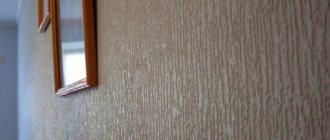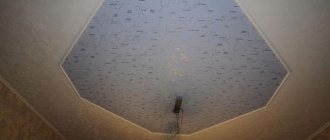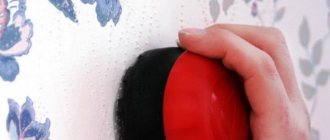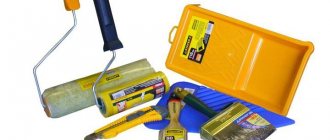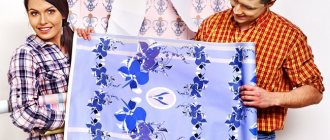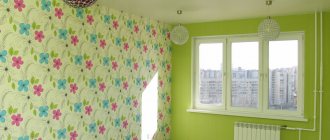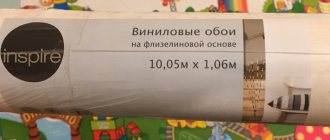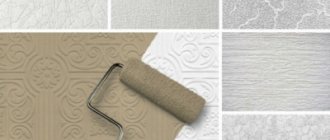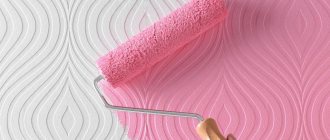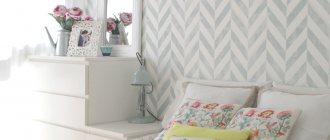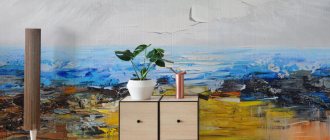About a quarter of a century ago, a fundamentally new type of wallpaper appeared in Europe - glass wallpaper. The new decorative coating quickly gained popularity all over the world. Fashion has not spared Russia either. But here consumers are faced with difficulties: well-studied wallpapering technologies either do not work at all, or work intermittently - fiberglass-based wallpaper either immediately slides off the walls or comes off after a couple of years.
Therefore, the editors of StroyGuru have prepared a material where gluing glass wallpaper for painting with your own hands is considered in detail: the characteristics of the finishing material are given, its strengths and weaknesses are considered, and a step-by-step technology for gluing it not only on walls, but also on the ceiling is given.
Features of glass wallpaper for painting
Fiberglass wallpaper is a finishing material for decorating walls and ceilings. It is made by drawing threads from molten glass and then making fabrics or canvas (non-woven material) using special equipment. To give the material strength, its surface is treated with a composition of modified starch and glue (experts call it impregnation).
Fiberglass wallpaper differs in texture, pattern, color and class (grade).
Texture. The older generation was left with the impression that fiberglass wallpaper was a roll of material with an incomprehensible pattern. Advances in technology have changed this perception. Fiberglass (gossamer) is smooth, fiberglass is textured, with a deep, clear pattern. The first type of wallpaper is used mainly for covering the ceiling, the second is intended for walls.
Fiberglass web.
The use of looms for the production of jacquard fabric in the manufacture of wallpaper made it possible to obtain a deep, varied relief.
Fiberglass fabric with herringbone pattern.
Pattern. The widely known patterns “matting”, “herringbone”, “check” are gradually losing their positions. They are being replaced by “rain”, “drop”, “rhombus”, “parquet”, etc.
Color. According to the idea of technologists and designers, glass wallpaper should be painted after pasting. Therefore, they are mainly sold in white. There are varieties: yellowish or slightly grayish.
Recently, dyed fabrics have appeared that do not require the application of dyes. True, their price is appropriate - more than 10.0 thousand rubles. per roll.
Class. In order not to show accurate data on density, some manufacturers began to use the concept of class (grade) of their products. As a result, all types of fiberglass trellises began to be divided into 3 classes:
- first - there is a variety: premium class;
- second;
- the third is also called economy class.
Are glass wallpapers harmful to health?
At the stage of the initial formation of embossed glass wallpaper, the main material was paint that was harmful to health, containing various heavy metals, which made it easy to paint the surface of the glass.
Now this statement has no basis. Today, glass wallpaper represents one of the most environmentally friendly types of wallpaper, since only sand with a high quartz content is used in their creation.
Don't hesitate when choosing similar children's wallpaper for walls for boys or girls. They are very impact-resistant, it’s not for nothing that they are called anti-vandal. This type of finish is fire-resistant, which eliminates large amounts of CO2 emissions during a fire.
Pros and cons of finishing options
A consumer interested in a new type of decor should know the pros and cons of glass wallpaper for painting. There are many strengths and they are impressive:
- durability - service life more than 30 years. Meticulous housewives will immediately object: in such a time, firstly, they will have time to get tired of family members, and secondly, they will lose their original appearance. This is where a few more advantages of this finishing option come in handy:
- the ability to repaint up to 20 times allows you to quickly change the interior with minimal loss of budget. The problem of familiar wallpaper is thus eliminated;
- the highest strength: glass wallpaper does not tear or deform when the building shrinks, it is almost impossible to damage it mechanically during operation. By the way, this feature of the decorative material is important for new buildings, where the processes of building shrinkage drag on for years;
- easy care - you can scrub dirty areas with a brush without the risk of damage;
- the high density of most types - 110-220 g/m2 - allows you to paint in any color without fear of visible spots and streaks.
- vapor permeability - the ability to transmit steam molecules allows the walls to “breathe”, which has a beneficial effect on the microclimate in an apartment or private house;
- fire safety - fiberglass does not burn, unlike other types of wallpaper;
- moisture resistance - can be glued in the bathroom and kitchen without fear of swelling and delamination of the finish;
- resistance to ultraviolet radiation, rodents, mold and mildew;
- environmentally friendly - no harmful substances are released when heated, there are no allergens in the composition;
- antistatic - the property of not accumulating free electrical charges helps in cleaning: dust practically does not accumulate on the walls.
There is one more advantage that plasterers highly appreciate: glass wallpaper, as a reinforcing mesh, perfectly keeps the putty layer from cracking when the building shrinks.
Unfortunately, for every barrel of honey there is always a fly in the ointment. Therefore, consumers need to be careful about the disadvantages of fiberglass wallpaper:
- the high price of both the wallpaper itself and the finishing in general - adds the cost of glue, which is also quite large, and coloring materials;
- loss of texture (pattern) after 3-4 stains;
- strict requirements for the type of paint - only acrylic and latex can be used;
- special glue is required;
- poor assortment;
- glass wallpaper for painting in the interior is not the best option in terms of design;
- high paint consumption - the porous structure of the material absorbs it well.
And the icing on the cake of disadvantages: removing wallpaper from the walls is extremely difficult. The process is labor-intensive, long, and dirty.
What is acrylic wallpaper?
The material is a two-layer coating, paper or vinyl and acrylic. Foamed acrylic is applied to a paper base using a dot method, according to the same principle as for vinyl wallpaper. As a result, an airy, breathable relief pattern is formed on the surface. The polymer coating is safe for interior decoration; acrylic does not emit harmful substances.
Main differences from vinyl
Acrylic wallpapers are similar in characteristics and production method to vinyl ones. However, they still have some differences.
- Acrylic and vinyl coatings have different thicknesses of the top layer; for vinyl it is 4 mm, for acrylic only two. This fact affects the wear resistance of the coating.
- Acrylic coating has a lower cost,
- Acrylic wallpaper has less moisture resistance.
Criteria for choosing glass wallpaper for painting
The peculiarities of glass wallpaper production sometimes make it difficult to choose. It may be impossible to visually distinguish high-quality products from defective ones. Knowledge of selection methods does not help either. For example, the density and thickness of the material can be increased by impregnation. But this will definitely have an effect during the pasting process - the canvas tears, deforms, loses elasticity, and sometimes decreases in size. As a result, the clarity of the drawing is disrupted.
The ideal solution to the problem is to cut a piece from the roll, stick it on a solid base (not advisable on the wall, because if the quality is good, it will take a long time to peel it off), let it dry, and paint it. The test is completed by pressing the spatula onto the trellises. If they are not deformed or change their appearance, the quality is high.
If this is not possible, the choice should be made according to the following parameters:
- density;
- composition;
- class;
- pattern.
Density. The density criterion determines the durability of the trellis. There is a direct relationship here: the denser, the longer the service life.
Wallpaper with a density of over 100 g/cm2 is considered high quality. But this is the lower limit of the indicator. You need to focus on the figure of 150 g/m2 (European manufacturers have a standard value of 145 g/m2). Deeply patterned fiberglass fabric (jacquard) can be even heavier, up to 220 g/m2.
But here, as with any rule, there are exceptions. For the ceiling, 25 g/m2 is enough - that’s how much smooth cobwebs weigh. But for walls, the web canvas should have an indicator of 45-50 g/m2.
Compound. Many buyers underestimate such a selection criterion as composition. But in vain. The strength and durability of the finish depend on the indicator. At the same time, deviation of the ratio of 70% fiberglass to 30% impregnation in any direction worsens the consumer characteristics of the finishing material.
Information about the composition should be on the insert. Its absence should alert the buyer.
Class. On the insert you can also find the class of wallpaper (Russian manufacturers indicate the grade, which is the same thing). You need to buy first class fiberglass trellises. When purchasing second-rate decor, the density must be at least 100 g/m2.
Pattern. For the ceiling you need smooth wallpaper - cobweb. For the walls, the pattern is chosen depending on the taste of the owners (“matting”, “herringbone”, “drops”). At the same time, a pattern with greater depth can be repainted more times - the pattern will be preserved.
How to choose glass wallpaper?
If we have already examined the main features and classifications of glass wallpaper, there is also a voluminous list of nuances that must be relied on when choosing a quality material. First of all, you should pay attention to the following factors:
- Density of the material. It is a key indicator of product quality. As mentioned earlier, natural starch can be added to the filler composition, which will help increase this value and will appear only at the gluing stage. As a result of contact with the adhesive, the starch particles will simply dissolve, which will lead to a “weak” porous structure. Unfortunately, it is impossible to identify such deception on your own, so we recommend using only trusted sellers and manufacturers, which we will talk about below.
- Relief pattern. The texture indicator can also be deliberately overestimated. The deception will only appear at the gluing stage, as a result of prolonged ironing with a roller and forcing out air bubbles. The way to avoid running into such glass wallpaper is similar to that described above: contact only suppliers with a good reputation.
- The ideal composition is a ratio of 70% glass and 30% impregnation,
- The edges of the roll should be smooth and the weaving neat.
The best glass wallpaper for the ceiling is the “cobweb” type. After painting, it forms a completely flat plane without relief patterns. In addition, it is glued without adjusting the pattern and has high reinforcing qualities.
Healthy! If it is not possible to find reviews about a specific seller of glass wallpaper, you can purchase 1 roll and verify its quality characteristics by gluing a small area yourself. Possible frauds that were listed earlier will appear at the first stage.
The selection of paint must be carried out taking into account the conditions and operating characteristics of the treated surface. Gloss or semi-gloss paint is preferred. In hallways and kitchens, it is recommended to use moisture-resistant compounds that are not prone to abrasion and destruction under the influence of aggressive detergents.
Popular manufacturers and prices
A well-known brand can guarantee quality. Among them are many world-famous companies producing fiberglass wallpaper:
- "Vitrulan";
- "Tassoglas";
- "Nortex";
- "Welton"
- "Oscar"
- "Bau Master";
- "X - Glass";
- "Saint-Gobain Novelio";
- "Waltex"
- "Veterman"
- "Mermet" etc.
"Vitrulan". Fiberglass wallpaper under the Vitrulan trademark is produced by the German concern Vitrulan Textile GMbH, the largest manufacturer in Europe. The company's technologists are constantly working to create a variety of lines of trellises, as a result of which they are distinguished by their smoothness, types of patterns, softness and color. And all this with quality that is commonly called German. The base price per 1 m2 ranges from 170-468 rubles.
"Tassoglas". The product of an American company with its factories in the USA, Europe and China. It achieved fame thanks to the widest range of surface textures among similar productions. Practical and high-quality fiberglass is used not only for finishing offices and organizations, but also for covering walls and ceilings in living rooms. Rarely found on sale. Costs from 82 to 450 rubles/m2, depending on density.
"Nortex". "Nortex" is a trademark of a Russian company. Production is located in China. Takes into account the requests of all buyer groups. Therefore, on the market you can find both premium-class wallpaper with a high density of 200 g/m2, and economy-class wallpaper with a density of up to 100 g/m2. They are distinguished by durability, a guarantee of over 30 years and a variety of patterns. The price range is significant. You can buy it for 66 rubles/m2 (“Medium matting”), and for 168 rubles/m2 (“Rain”).
Welton. A Swedish brand with established production in many countries of the world: Germany, Russia, Czech Republic, Finland and China. All production facilities produce high quality products with stylish design. The cost of 1 m2 is about 208 rubles.
"Oscar". Subsidiary, but with more affordable prices and good quality - 69-107 rubles/m2.
"Bau Master" China. They are distinguished by affordable prices and good quality. The cheapest wallpaper can be bought for around 33 rubles/m2, the most expensive - 130 rubles/m2.
"X - Glass." Russian manufacturer with a wide range of glass fiber and canvas in the middle price range. For example, fiberglass fabric can be found on sale for 47-80 rubles/m2.
If we consider specific wallpaper models, their rating for mid-2022 is as follows:
1. "Vitrulan Acoustic 904 Labyrinth". The wallpaper is unique in that a layer of heat and sound insulation is applied to the reverse side (reduces noise by about 2 times). Their density is 610 g/cm2, dimensions are 10.4 x 0.96 m, price is 20,866 rubles. per roll.
2. “Vitrulan Aqua Plus 604 phantasy microcrepe.” The highlight is that there is no need to select a design or buy glue - it is already applied to the back side. Density - 200 g/m2, dimensions - 1 x 25 m, price - 9400 rubles. per roll.
3. “Brattendorf B021 Rain.” German quality products costing about 9,360 rubles.
4. "Novelio Checkers 1023". Czech glass wallpaper 25 m long, density 195 g/m2, priced at 4,078 rubles per roll.
5. "X - Glass Gold." Finishing finishing material with a price of 3200 rubles. per roll.
Materials and tools
Decorating walls or ceilings with fiberglass wallpaper requires the purchase of:
- several rolls of glass wallpaper;
- special glue (“Oscar”, “Kleo”, “Metylan”);
Glue "Oscar".
- primers;
- acrylic or latex paint.
Tools and equipment you will need:
- stepladder or strong table;
- a screwdriver with a mixing attachment for stirring dry glue (ready-to-use adhesives can also be found on sale);
- container for glue and water;
- cuvette - needed for primer, glue and paint;
- brushes for applying primer, glue and paint;
- paint rollers with a telescopic handle - will be required when priming and painting walls (ceilings);
- plumb line;
- pencil;
- roulette;
- scissors;
- knife with removable blade;
- wallpaper spatula;
Wallpaper spatula.
- sponge;
- rags (rags).
Types of paint
In each case, a certain type of wallpaper paint can be used:
- It is better to paint non-woven wallpaper with acrylic or water-based paint;
- paper - only water-based;
- fiberglass - acrylic or latex paint.
- Acrylic paint is distinguished by its positive properties:
- moisture resistant;
- has popular matte shades;
- environmentally friendly;
- has no pungent odors;
- dries quickly.
Preparatory work
Wallpaper made of fiberglass or canvas can only be applied to a well-prepared wall (ceiling). If you ignore this stage of finishing, the resulting decor will be short-lived (it will quickly begin to lag), with many defects (the paint emphasizes any unevenness). Preparatory work is carried out in the following sequence:
- sockets, switches, wall lamps, various fasteners in the form of screws, nails, etc. are removed;
- old finishing is removed;
- the surface is cleaned of dirt, grease, soot;
- cracks, chips, sinks are repaired, and masonry joints are restored in the brick wall;
- walls (ceiling) are leveled. You can use plasterboard (dry plaster) or a mortar based on cement or gypsum (wet plaster);
- the final leveling of the wall (ceiling) is carried out using putty;
- The surface is primed before gluing. If for paper wallpaper the procedure can be ignored, then in the case of fiberglass trellises, applying a primer is mandatory - the wallpaper together with the paint may not withstand the glue.
In this work, it is not possible to consider the details of the preparatory work. If you have any questions, you can follow the link to the material “How to prepare walls for wallpapering?”, where everything is explained in detail.
Gluing technology
After the surface of the wall or ceiling is leveled and then primed, proceed to the main finishing phase: wallpapering. Let's take a closer look at how to glue glass wallpaper for painting onto walls with your own hands.
Preparation of glue
Fiberglass wallpaper fabric weighs on average 145 g/m2. This is a lot for wallpaper. Therefore, glue for paper or non-woven wallpaper will not hold such weight on the wall. The problem is made worse by the paint, which increases the pull-out stress.
Trying to prepare an adhesive composition at home using PVA also does not solve the problem - the wallpaper will begin to fall off literally from the first day. You need a special adhesive for fiberglass wallpaper. Almost all major manufacturers of fiberglass trellises also supply glue to the construction market. It can be in powder form or ready to use.
The powder is prepared as follows:
- the amount of warm water specified in the preparation instructions is poured into the mixing container;
- the water is spun by hand or any object until a funnel is formed;
- the entire pack of powder is poured onto the edge of the funnel in a small stream;
- Stirring continues until a homogeneous consistency without lumps is formed. A screwdriver with a mixing attachment will help speed up the work;
- the mixed mass is left for some time (must be indicated on the packaging) to mature;
- the glue is kneaded again for 2-3 minutes, but without a mixer (some types of glue do not require re-mixing, about which there is information in the instructions for use).
Attention: if the glue is too thick, you can add about 200 ml of water, but only within 30 minutes after starting stirring.
Wall marking
While the glue is maturing, markings are applied to the wall using a plumb line and a pencil. It is believed that one vertical line is enough for the starting sheet. Many years of experience show that 8 lines simplify the work: in each starting corner, one is at a distance of 2-3 cm from the wall, the other is at a distance from the first, equal to the width of the roll.
A method of drawing a vertical line on a wall.
The recommendation to draw lines for each sheet of trellis does not work: after gluing 2-3 strips, all calculations are lost.
Pasting instructions
The process of gluing canvases includes the following steps:
- in the room where the work will be carried out, the windows are tightly closed - even small drafts can ruin all the work done;
- the distance from floor to ceiling is measured;
- the trellis sheets are cut either to size (the pattern will be adjusted by moving the sheet horizontally, i.e. overlapping), or with a tolerance of 8-10 cm (the pattern will be aligned vertically);
- Glue is applied to the wall with a roller or brush. The width of the passage is equal to the width of the sheet + 3-4 cm;
- the first trellis is glued with its edge along a vertical line;
Attention: fiberglass wallpaper has a front and back side. A gray or blue stripe is applied to the latter.
- Using a wallpaper roller or plastic spatula, the trellis sheet is rolled onto the wall surface. Movements are performed from top to bottom, from the center to the edges. The protruding glue is removed with a rag or sponge;
- the second sheet is glued end-to-end if the pattern is adjusted vertically, or overlapping (horizontally). In this case, using a metal ruler and a construction knife, a cut is made along the sheets that overlap each other, which will form a beautiful seam. By the way, this option is better suited for beginners than adjusting the pattern vertically;
A vertical seam is formed.
- the pasted canvas is rolled to the wall. Particular attention should be paid to the connecting seam. It is rolled with force several times with a small roller. If the edge of the sheet does not stick - the glue has dried - the fiberglass is removed from the wall, onto which the glue is re-applied;
The wallpaper is cut off.
As a rule, difficulties arise when passing corners. There are many nuances here, which are covered in detail in the work “How to glue wallpaper in corners.”
The nuances of pasting the ceiling
You can apply wallpaper on the ceiling using the same technology as for walls. However, there are several nuances:
- The trellises should be light - for this purpose it is better to use fiberglass web. Fiberglass glue does not withstand vertical tearing;
- you need to glue from the window to the opposite wall - the joint is not so noticeable;
- you need an adhesive specially designed for fiberglass - other types of adhesive do not have enough adhesive force to hold the trellis on the ceiling;
- the adhesive mass is applied only to the surface of the ceiling;
- glue for the next strip is spread after gluing the previous one;
- gluing is carried out end-to-end, going onto the walls. The option of overlapping gluing is not used due to the difficulty of cutting the double sheet. That is, what can be done on the walls does not go to the ceiling;
- After the glue has partially dried, the trellises that have entered the wall are cut off. Many craftsmen advise carrying out the operation after the glue has completely dried. But then problems arise with removing the scraps - after all, they partially stick to the wall.
Important: When removing scraps of wallpaper from the wall, you need eye protection, as shards of fiberglass fly in all directions.
How to remove glass wallpaper from walls?
If you decide to remove glass wallpaper from the wall in order to apply other canvases, for example, 3D space-expanding photo wallpaper, or non-woven wallpaper, then use a spatula. The main difference is the impossibility of using various means of liquefying the glue - a steam generator or ordinary water will not pass through the dense structure.
Start working from top to bottom - this way the canvases move away under their own weight. While working, follow a number of specific safety rules:
- carry out dismantling only with gloves;
- remove slowly, otherwise they will break and become unusable, making it difficult to clean the room later.
After removal, the canvas does not have to be thrown away - embossed wallpaper will be an excellent material for decorating an impromptu gazebo or otherwise decorating an area.
